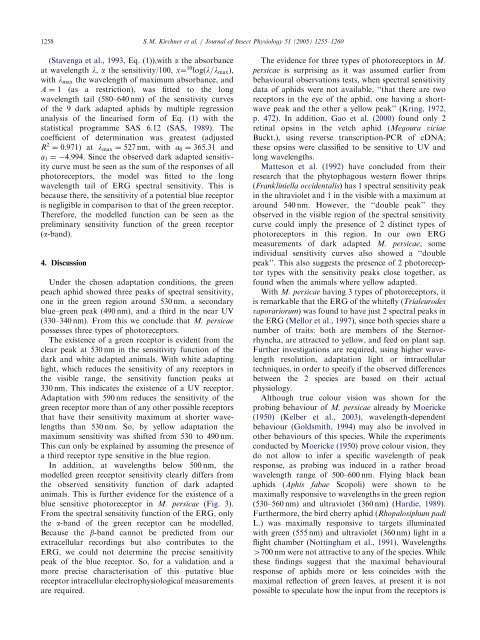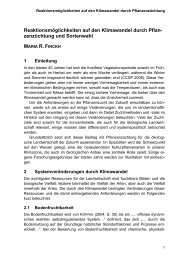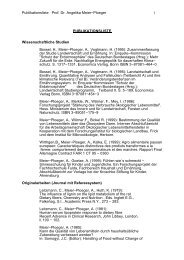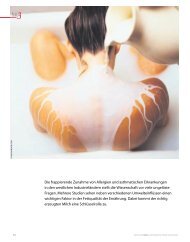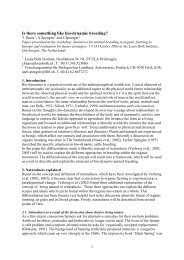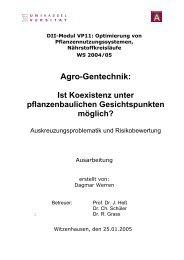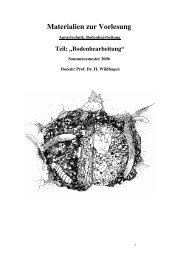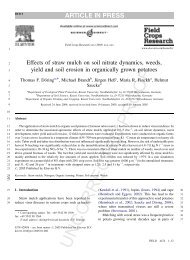Evidence for trichromacy in the green peach aphid, Myzus persicae ...
Evidence for trichromacy in the green peach aphid, Myzus persicae ...
Evidence for trichromacy in the green peach aphid, Myzus persicae ...
You also want an ePaper? Increase the reach of your titles
YUMPU automatically turns print PDFs into web optimized ePapers that Google loves.
1258<br />
(Stavenga et al.,1993,Eq. (1)),with a <strong>the</strong> absorbance<br />
at wavelength l, a <strong>the</strong> sensitivity/100, x¼ 10 logðl=lmaxÞ,<br />
with lmax <strong>the</strong> wavelength of maximum absorbance,and<br />
A ¼ 1 (as a restriction),was fitted to <strong>the</strong> long<br />
wavelength tail (580–640 nm) of <strong>the</strong> sensitivity curves<br />
of <strong>the</strong> 9 dark adapted <strong>aphid</strong>s by multiple regression<br />
analysis of <strong>the</strong> l<strong>in</strong>earised <strong>for</strong>m of Eq. (1) with <strong>the</strong><br />
statistical programme SAS 6.12 (SAS,1989). The<br />
coefficient of determ<strong>in</strong>ation was greatest (adjusted<br />
R 2 ¼ 0:971) at lmax ¼ 527 nm,with a0 ¼ 365:31 and<br />
a1 ¼ 4:994. S<strong>in</strong>ce <strong>the</strong> observed dark adapted sensitivity<br />
curve must be seen as <strong>the</strong> sum of <strong>the</strong> responses of all<br />
photoreceptors,<strong>the</strong> model was fitted to <strong>the</strong> long<br />
wavelength tail of ERG spectral sensitivity. This is<br />
because <strong>the</strong>re,<strong>the</strong> sensitivity of a potential blue receptor<br />
is negligible <strong>in</strong> comparison to that of <strong>the</strong> <strong>green</strong> receptor.<br />
There<strong>for</strong>e,<strong>the</strong> modelled function can be seen as <strong>the</strong><br />
prelim<strong>in</strong>ary sensitivity function of <strong>the</strong> <strong>green</strong> receptor<br />
(a-band).<br />
4. Discussion<br />
Under <strong>the</strong> chosen adaptation conditions,<strong>the</strong> <strong>green</strong><br />
<strong>peach</strong> <strong>aphid</strong> showed three peaks of spectral sensitivity,<br />
one <strong>in</strong> <strong>the</strong> <strong>green</strong> region around 530 nm,a secondary<br />
blue–<strong>green</strong> peak (490 nm),and a third <strong>in</strong> <strong>the</strong> near UV<br />
(330–340 nm). From this we conclude that M. <strong>persicae</strong><br />
possesses three types of photoreceptors.<br />
The existence of a <strong>green</strong> receptor is evident from <strong>the</strong><br />
clear peak at 530 nm <strong>in</strong> <strong>the</strong> sensitivity function of <strong>the</strong><br />
dark and white adapted animals. With white adapt<strong>in</strong>g<br />
light,which reduces <strong>the</strong> sensitivity of any receptors <strong>in</strong><br />
<strong>the</strong> visible range,<strong>the</strong> sensitivity function peaks at<br />
330 nm. This <strong>in</strong>dicates <strong>the</strong> existence of a UV receptor.<br />
Adaptation with 590 nm reduces <strong>the</strong> sensitivity of <strong>the</strong><br />
<strong>green</strong> receptor more than of any o<strong>the</strong>r possible receptors<br />
that have <strong>the</strong>ir sensitivity maximum at shorter wavelengths<br />
than 530 nm. So,by yellow adaptation <strong>the</strong><br />
maximum sensitivity was shifted from 530 to 490 nm.<br />
This can only be expla<strong>in</strong>ed by assum<strong>in</strong>g <strong>the</strong> presence of<br />
a third receptor type sensitive <strong>in</strong> <strong>the</strong> blue region.<br />
In addition,at wavelengths below 500 nm,<strong>the</strong><br />
modelled <strong>green</strong> receptor sensitivity clearly differs from<br />
<strong>the</strong> observed sensitivity function of dark adapted<br />
animals. This is fur<strong>the</strong>r evidence <strong>for</strong> <strong>the</strong> existence of a<br />
blue sensitive photoreceptor <strong>in</strong> M. <strong>persicae</strong> (Fig. 3).<br />
From <strong>the</strong> spectral sensitivity function of <strong>the</strong> ERG,only<br />
<strong>the</strong> a-band of <strong>the</strong> <strong>green</strong> receptor can be modelled.<br />
Because <strong>the</strong> b-band cannot be predicted from our<br />
extracellular record<strong>in</strong>gs but also contributes to <strong>the</strong><br />
ERG,we could not determ<strong>in</strong>e <strong>the</strong> precise sensitivity<br />
peak of <strong>the</strong> blue receptor. So,<strong>for</strong> a validation and a<br />
more precise characterisation of this putative blue<br />
receptor <strong>in</strong>tracellular electrophysiological measurements<br />
are required.<br />
ARTICLE IN PRESS<br />
S.M. Kirchner et al. / Journal of Insect Physiology 51 (2005) 1255–1260<br />
The evidence <strong>for</strong> three types of photoreceptors <strong>in</strong> M.<br />
<strong>persicae</strong> is surpris<strong>in</strong>g as it was assumed earlier from<br />
behavioural observations tests,when spectral sensitivity<br />
data of <strong>aphid</strong>s were not available,‘‘that <strong>the</strong>re are two<br />
receptors <strong>in</strong> <strong>the</strong> eye of <strong>the</strong> <strong>aphid</strong>,one hav<strong>in</strong>g a shortwave<br />
peak and <strong>the</strong> o<strong>the</strong>r a yellow peak’’ (Kr<strong>in</strong>g,1972,<br />
p. 472). In addition, Gao et al. (2000) found only 2<br />
ret<strong>in</strong>al ops<strong>in</strong>s <strong>in</strong> <strong>the</strong> vetch <strong>aphid</strong> (Megoura viciae<br />
Buckt.),us<strong>in</strong>g reverse transcription-PCR of cDNA;<br />
<strong>the</strong>se ops<strong>in</strong>s were classified to be sensitive to UV and<br />
long wavelengths.<br />
Matteson et al. (1992) have concluded from <strong>the</strong>ir<br />
research that <strong>the</strong> phytophagous western flower thrips<br />
(Frankl<strong>in</strong>iella occidentalis) has 1 spectral sensitivity peak<br />
<strong>in</strong> <strong>the</strong> ultraviolet and 1 <strong>in</strong> <strong>the</strong> visible with a maximum at<br />
around 540 nm. However,<strong>the</strong> ‘‘double peak’’ <strong>the</strong>y<br />
observed <strong>in</strong> <strong>the</strong> visible region of <strong>the</strong> spectral sensitivity<br />
curve could imply <strong>the</strong> presence of 2 dist<strong>in</strong>ct types of<br />
photoreceptors <strong>in</strong> this region. In our own ERG<br />
measurements of dark adapted M. <strong>persicae</strong>,some<br />
<strong>in</strong>dividual sensitivity curves also showed a ‘‘double<br />
peak’’. This also suggests <strong>the</strong> presence of 2 photoreceptor<br />
types with <strong>the</strong> sensitivity peaks close toge<strong>the</strong>r,as<br />
found when <strong>the</strong> animals where yellow adapted.<br />
With M. <strong>persicae</strong> hav<strong>in</strong>g 3 types of photoreceptors,it<br />
is remarkable that <strong>the</strong> ERG of <strong>the</strong> whitefly (Trialeurodes<br />
vaporariorum) was found to have just 2 spectral peaks <strong>in</strong><br />
<strong>the</strong> ERG (Mellor et al.,1997),s<strong>in</strong>ce both species share a<br />
number of traits: both are members of <strong>the</strong> Sternorrhyncha,are<br />
attracted to yellow,and feed on plant sap.<br />
Fur<strong>the</strong>r <strong>in</strong>vestigations are required,us<strong>in</strong>g higher wavelength<br />
resolution,adaptation light or <strong>in</strong>tracellular<br />
techniques,<strong>in</strong> order to specify if <strong>the</strong> observed differences<br />
between <strong>the</strong> 2 species are based on <strong>the</strong>ir actual<br />
physiology.<br />
Although true colour vision was shown <strong>for</strong> <strong>the</strong><br />
prob<strong>in</strong>g behaviour of M. <strong>persicae</strong> already by Moericke<br />
(1950) (Kelber et al.,2003),wavelength-dependent<br />
behaviour (Goldsmith,1994) may also be <strong>in</strong>volved <strong>in</strong><br />
o<strong>the</strong>r behaviours of this species. While <strong>the</strong> experiments<br />
conducted by Moericke (1950) prove colour vision,<strong>the</strong>y<br />
do not allow to <strong>in</strong>fer a specific wavelength of peak<br />
response,as prob<strong>in</strong>g was <strong>in</strong>duced <strong>in</strong> a ra<strong>the</strong>r broad<br />
wavelength range of 500–600 nm. Fly<strong>in</strong>g black bean<br />
<strong>aphid</strong>s (Aphis fabae Scopoli) were shown to be<br />
maximally responsive to wavelengths <strong>in</strong> <strong>the</strong> <strong>green</strong> region<br />
(530–560 nm) and ultraviolet (360 nm) (Hardie,1989).<br />
Fur<strong>the</strong>rmore,<strong>the</strong> bird cherry <strong>aphid</strong> (Rhopalosiphum padi<br />
L.) was maximally responsive to targets illum<strong>in</strong>ated<br />
with <strong>green</strong> (555 nm) and ultraviolet (360 nm) light <strong>in</strong> a<br />
flight chamber (Nott<strong>in</strong>gham et al.,1991). Wavelengths<br />
4700 nm were not attractive to any of <strong>the</strong> species. While<br />
<strong>the</strong>se f<strong>in</strong>d<strong>in</strong>gs suggest that <strong>the</strong> maximal behavioural<br />
response of <strong>aphid</strong>s more or less co<strong>in</strong>cides with <strong>the</strong><br />
maximal reflection of <strong>green</strong> leaves,at present it is not<br />
possible to speculate how <strong>the</strong> <strong>in</strong>put from <strong>the</strong> receptors is


